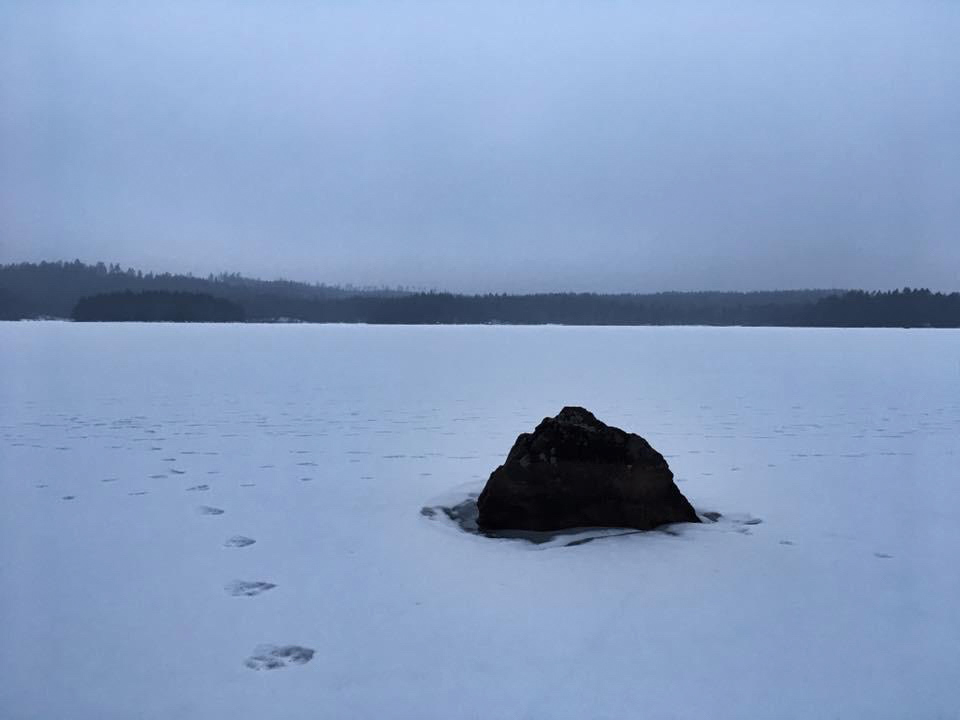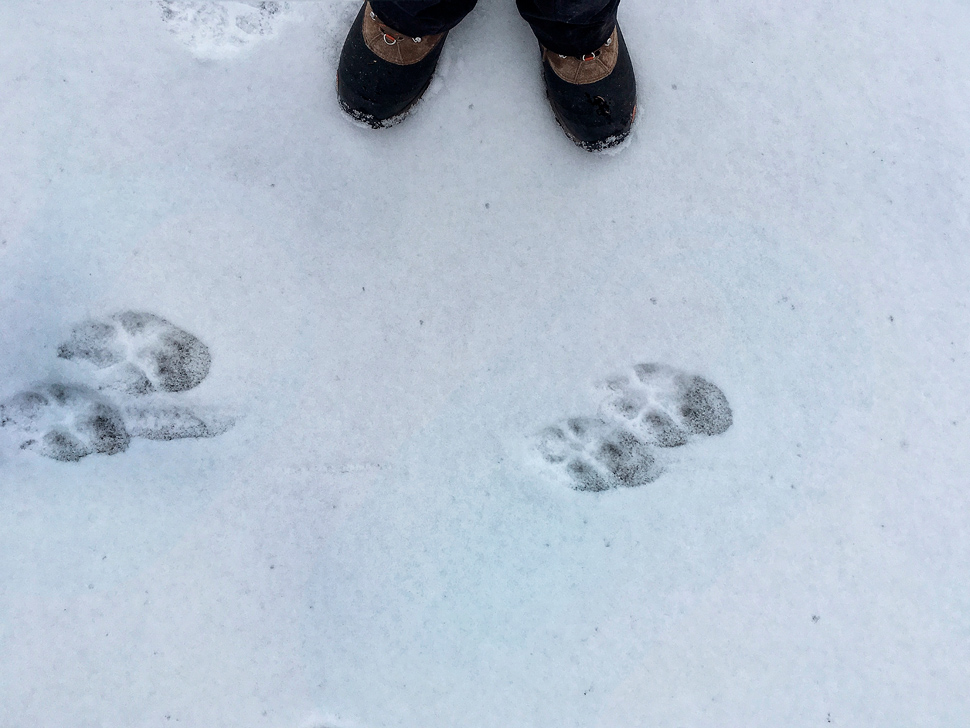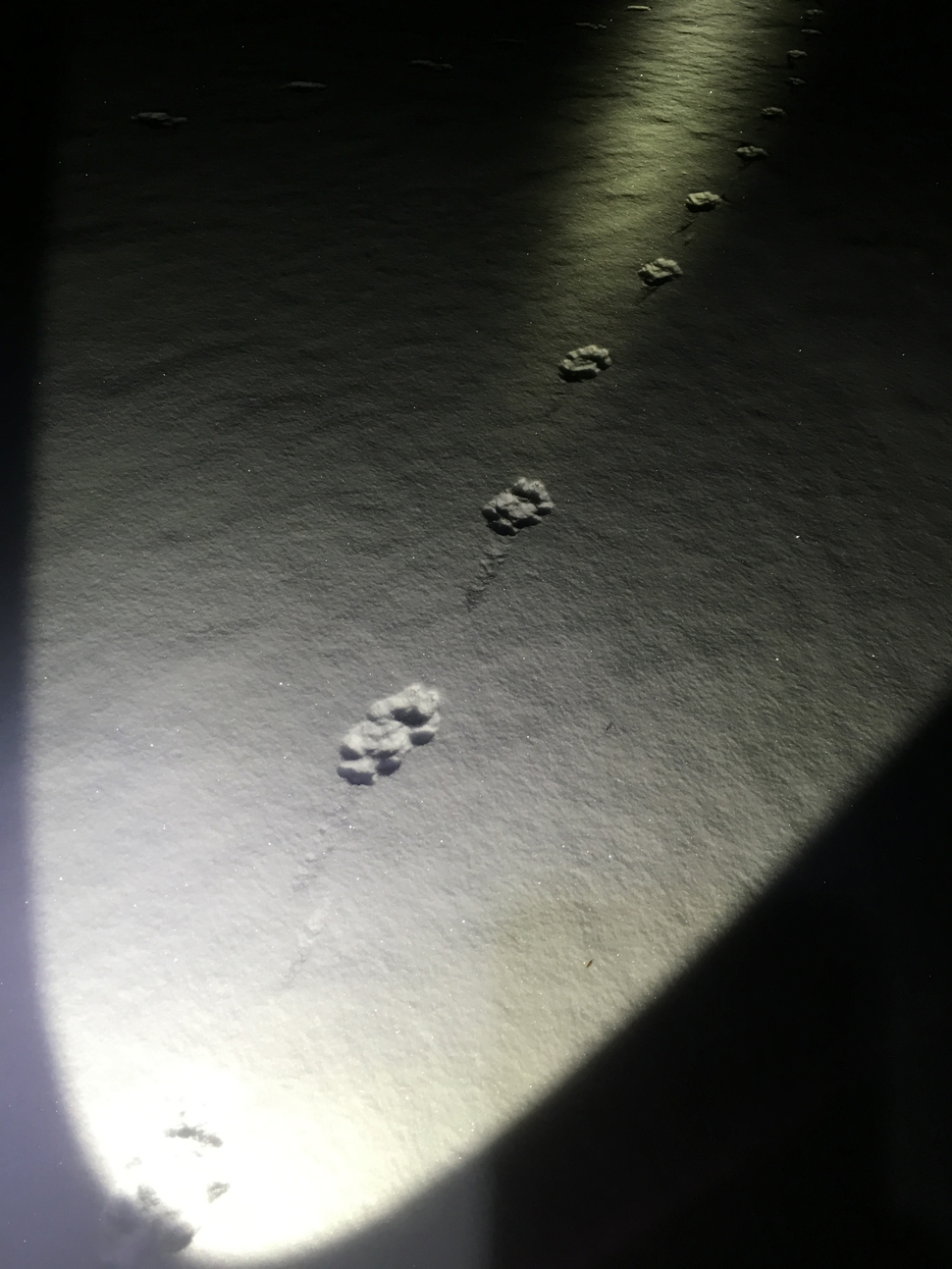- Home |
- Search Results |
- William Henry Searle on tracking wolves: ‘They have stirred in me a basic appetite to slow down’
William Henry Searle on tracking wolves: ‘They have stirred in me a basic appetite to slow down’
In Threads, William Henry Searle celebrates the quiet moments and conversations that nourish us. He describes his time tracking wolves in the snowy wilds of Sweden, and how it inspired him to escape the routines of life.

Before I even had the chance to raise my binoculars to my eyes, the white-tipped eagle was long gone into the far grey, its huge and serrated wings visible as a dark movement in the distant sky. Snow, released from the high fir bough that was still bouncing from the bird’s departed weight, wafted and rasped into the branches below. A wind harried through, finding its way through the forest. The air became a sudden pressing of scabrous ice against my cheek. I looked for the eagle between the spaces of moving trees. I looked and I breathed.
A line of wolf tracks ran out over the frozen, snow-covered lake. I could see, from the bank, that they formed a sharp arc that swung out from the shore and back into the lake’s centre where a single large boulder was clearly visible, drawing my eye like a beacon. But I could not see where the tracks continued. One by one we cautiously stepped onto the ice. The wind returned, picking up the snow and spinning it out widely and thinly until it blended with the air, adding to it a cold, granular texture. The slow crunch of our boots, the stillness as we stopped beside the tracks and gazed into them, the silence as we fell, each one of the group, into mesmerised interest – these rhythms became hypnotic. I placed my bare hand lightly onto the precious tracks, and let my mind wander with an imagined scenario of a lone wolf, out here, loping through the snow, stopping, just as we were, to take in her surroundings. Her fur, her paws, her eyes. The magnetism of her identity, inseparable from the landscape in which she roamed. I was full of admiration, entranced.

The guide would not allow us to go out to the boulder as it was surrounded by thinner ice, a white blue ring of slush circling the dark pupil of the stone while the green trees surrounded the lake like eyelashes. An observant geography. The wolf tracks disappeared at the rock. Not a single one deviated out, cut back in, or ran straight on. Only a few hours previously, that morning perhaps, a wolf was there at the rock. We scanned the landscape. We moved and scanned. I kept looking back at the boulder. I had the distinct sense that the rock – not inert but living – was watching us.
We made our way around the edge of the lake, eyes to the ground then to the distance. Stopping organically, and not under instruction from the guide, we listened out, for a murmuring howl perhaps, or the echo of one at least. Two ravens barrel-rolled over the trees, lobbing out such guttural croaks that we couldn’t help but listen. We found no more tracks. They simply ended at the boulder. Perhaps a fresh snow had covered them. I tried to fill in the gaps, invent a story that may have been the truth.
That evening, as I lay in my warm bed at the guesthouse, the wolf was never far from my mind. I imagined the sound of her paw as it cracked the snow crust and lifted free, as she moved relentlessly beneath the stars, towards the winter source of what drives her onward. And the silence and darkness of the landscape at night, punctuated by her breathing and flood-lit by a gibbous moon rising at midnight through pine trees. Lunar ice and snow.

I imagined the sound of her paw as it cracked the snow crust and lifted free, as she moved relentlessly beneath the stars, towards the winter source of what drives her onward.
On another trip, a year later, we came across a kill. A moose. Later I was given the information, at my request, that it was cow no. 374. I found the tag beneath the snow, bloodied and still attached to part of the ear. I kept it as a souvenir. We had been following wolf tracks, a pair, along an abandoned forestry road that served as an ideal corridor for wolves to gain uninterrupted distance through an otherwise densely forested wilderness. Hanging back from the rest of the group, I inspected signs of their presence with forensic dedication. I even got on my hands and knees to sniff their markings, dropped faeces and splashes of urine stark yellow against the pristine white of the snow. I wanted to immerse myself in every trace of them so that despite never seeing the wolf itself, all the signs, taken together, were enough to evoke their enigmatic presence.
A thick smell, heavy in the crisp, buoyant air, led us off the road and into the forest, into knee-deep, hip-deep snow. The outline of the wolves could be made out, sunken where they had jumped forward through the snow, their bellies sitting briefly on the surface as they chased down the moose into the forest. Low branches were broken here and there, twigs snapped, moose prints like post-holes scattered in a frenzy of escape. The kill-site was a further fifty yards or so onward. A mayhem of tracks, scrapings, snow banked up against branches coloured by spatterings of blood. The smell foul and acrid. I brought my green buff up around my nose, and trod carefully through the mess of stomach contents, ripped flesh, torn spine and bones strewn in all directions.
There were more than two wolves, evidenced by the presence of tracks coming from the north, in the opposite direction to the ones we followed. Fox tracks, the print of an eagle’s wings in the snow as it landed, shuffled and took off, raven tracks, and more. An abundance of life in a place of obliteration. The carcass as an open gift, ugly and necessary for life to flourish. A co-ordination between predator and prey that benefits more than can be calculated. I found the skull, picked clean, abrasions across its skull, the blood as luminous as crimson light, a lantern. I stared at it for a while. The commotion of the kill was busy in my mind but gave way, eventually, to the silence and stillness of the aftermath.

That night we camped out in a nearby pine forest, to be close to the kill, to discover if the wolves would return to take the final scraps of flesh. We talked of the wolves around the camp-fire, with more understanding of how necessary they are not only for the wealth of the ecosystem but also for us, our raw inner life, as human-animals. In a world shrunken tight and made mystery-poor by our fanatic need to dominate, know, and control, we need a more spacious, expansive sense of what constitutes life. People aren’t everything.
Stars glittered. Dusty snows spilled, intermittently, from the scoop of the Big Dipper, hissing into the fire. The guide howled out to the night, three howls over a few minutes. My heart raced with expectancy for the wolves’ reply. I tried to stay up through the night but the cold made it difficult to concentrate on anything but the cold, and I stayed warm bundled in the layers of two sleeping bags. I couldn’t wait for the morning, to follow more wolf tracks, to be led beyond what I could guess at, into what the day may bring.
--
Again, this February, I am going to track wolves. To put my hand besides their paw prints, to kneel down, to slow and focus my mind and body on nothing but them and the snowy forests and frozen lakes of central Sweden. They have stirred in me a basic appetite to slow down, listen, look, engage the wild nerves of every wild sense. To share a place with wolves, if only for a few days, brings about a feeling of liberation from the stuffy restrictions and predictable routines of the months gone and the months ahead. The wolves, if only their traces, see me through for the rest of year. Their tracks, like time, not our notion of time, weave this way and that into the uncertainty of the darkness and engage my wildness. I hope they have not been culled.